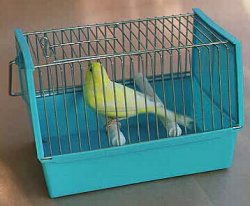
First, you need to decide how many birds you will get and what gender. Most people want a male canary because males sing. You should get one cage for each male because they are very territorial and will fight with each other. If it isn’t breeding season, they may even fight with a hen. Some people prefer hens, because they are more sociable. You can put several hens together in a flight or aviary.
It is a common mistake to buy a young male and then discover it is actually a hen. Most people get attached to the bird and are reluctant to return it when they discover the mistake. Since males are more expensive, ask for a written guarantee when you buy a male, especially if buying from a business. If the bird does not sing within two weeks, return it. Either exchange it for a singing male, or get a partial refund price for the less expensive female.
It is very important to realize that young canaries are basically androgynous. Even experts make mistakes about gender before a bird’s first breeding season. Both males and females may sing a baby song from about age 4 weeks until the summer molt. By fall, most males start to sing their adult song, which is facilitated by listening to older males. Buying a bird too soon deprives it of this post-molt tutoring period and can result in a less varied song. Some hens continue to sing the baby song and some even develop a decent adult song, so even experts are occasionally fooled. In the spring when the birds come into breeding condition, an experienced breeder can usually tell them apart by examining the vent area.
You can tell the approximate age of a canary wearing a closed (seamless) metal leg band with the year stamped on it. This type of band can only be put on the chick when it is about a week old. Since the bands are only issued in the year stamped, it is proof of how old the bird is. In addition to the year, check the band for breed information. Letters indicate the society or club that issued the band, which could indicate what breed of canary it is. Sometimes letters and numbers indicate the breeder. If you buy a bird without a closed band, you have to take the seller’s word about the age and breed. A canary might also have colored plastic bands or a metal band with a seam. These open bands can go on and come off any time. They are used by breeders to help organize their birds. Ask the seller to explain the purpose of all bands on the bird and to decode any numbers for you.
There are many breeds of canaries and you could do a lot of research trying to decide which to get. A more practical approach may be, what is available in your area? It is best to buy directly from a breeder. To find canary breeders, contact a bird club, veterinarian, or look for ads in the paper. Some pet shops that only sell supplies give referals, or have “message” boards with business cards you can check.
If you want a singing pet, then try to pick out a bird that you have actually heard singing. A pet shop that also carries screeching parrots is a poor place to even hear a canary, let alone choose between the songs of different individuals! The ideal situation is to make an appointment with a breeder who will set up a separate “listening” room with just the birds that are for sale. Breeders are sometimes reluctant to let strangers into their bird room. It helps to be a member of a local club, or be referred by a friend. To get a breeder to allow you into their home or aviary, assure them you are responsible and serious about getting a good bird. The more research you do and the more knowledgable you sound, the better your chances. These things will also help:
- Promise to call the day before and confirm the appointment. Promise to call if you are late or need to cancel.
- Tell who is coming with you. Keep this to one other adult, no small children, and no other pets.
- Restrict your buying interest to the birds offered for sale; the best birds must be kept for breeding, so don’t ask to buy them.
- Get a price range before you go. Offer to pay cash. Bring enough small bills.
- Mention that you are bringing a cage to take the bird home in. Show up carrying it.
- Be sensitive about conducting “business” in a residential area, keep a low profile and do not disturb the breeder’s neighbors.
If you fail to find a cooperative breeder, then the next best place to buy a canary is at a bird show. Breeders who exhibit birds in competition often sell excess birds right off the show bench at the end of the show. A show bird which failed to win is still likely to be a superior pet! Shows may also have a sales area which can be a good place to find canary breeders. There are also bird marts or bird fairs which focus only on sales, no judging. But beware! Some very good birds can be found there, but also some of the poorest and unhealthiest.
Regardless of where you buy your canary, you need to recognize a healthy bird. First look at how clean the cage is. Are the droppings watery? Is the cage overcrowded? Even at a bird mart, a conscientious breeder doesn’t cram so many birds in a cage that all cannot perch comfortably. A weak or sick bird will become too tired to defend itself and will quickly become pecked on. A healthy bird looks well groomed, alert, has clear eyes and no nasal discharge.
If you are seriously considering buying a bird, have the seller catch it for you. Put the bird up to your ear and listen to its breathing. It is normal for it to pant and be upset, but you should not hear wheezing or clicking. Touch the bird’s chest to try to feel its breastbone. If the breastbone is very prominent, the bird is too thin and may be sick. Do not make the mistake of feeling sorry for a poor looking bird and buying it to “rescue” it. That just rewards the seller for allowing the bird to get in that condition and may cause you big problems and vet bills.
A written health guarantee is not usually provided by private sellers because many problems that develop after a sale are the fault of the buyer. Changing homes is stressful to a bird and makes it more susceptible to illness. A perfectly healthy bird can became ill quickly if exposed to drafts, if it lacks food or water for long, or if the diet offered is substantially different from the one which had been fed previously. Buying from a reputable source and knowing how to properly care for the bird is your best guarantee of continued health. Get a book on canary care and reread it occasionally to refresh your memory on their needs.
If you are buying from an individual (as opposed to a business) that you do not know, offer to pay cash. In return, the seller should provide a written receipt with band number. A responsible seller should also be willing to give you a food sample and written care instructions. If the bird’s toenails are long, ask the seller to demonstrate how to trim them.
In the U.S., prices can vary from $10 for an old hen to $200 or more for a show-quality bird from a top breeder, one who has won consistently at national shows. Most male canaries cost between $50-$125 at pet shops. Ironically, breeders usually charge less even though the birds are often better! (Breeders do not have the overhead of a store.) If you are buying directly from a breeder, ask for a price range before you make the appointment. If you are thinking of buying several birds, ask if there would be a discount for quantity. Then, do not insult the breeder by haggling when you are ready to buy. Be prepared to pay cash and avoid needing change.
If possible, have your own small carrying cage to carry the bird home. Pet shops and dealers usually provide paper bags or small cardboard boxes, but I believe it is less stress on a canary if it can sit on a perch and see. Do not use a clear plastic box; I actually had a customer put a bird in one and it promptly injured itself trying to fly out! Make sure the cage doors are securely closed before you leave the room. Cover the cage with a light towel or cloth while carrying it outside and while in a vehicle. While driving home, protect the bird from drafts and temperature stress. Once home, you can introduce your new pet to its large main cage. The carrying cage will come in handy when cleaning the main cage, or if it is necessary to transport the bird in the future.
If you already have pet birds, it is a good idea to quarantine the new bird for a few weeks. This not only protects the current birds from possible introduction of diseases and parasites, but benefits the new bird as well. The stress of changing homes may make the new canary more susceptible to unfamiliar strains of normally harmless bacteria carried by the existing birds. Isolation will result in gradual indirect exposure so it can build up a tolerance.
Once the bird has settled into its new home, call the breeder or write them a note letting them know all is well. Thank them for the time they spent helping you with the purchase. If the bird is a singer, let them know how long it took him to start singing. I’ve always appreciated hearing from happy customers and that is part of the satisfaction of this hobby!
To summarize my recommendations for buying a canary:
- Wait until Fall to be confident of the gender of young birds
- If possible, buy directly from a reputable breeder
- To be sure of the birth year or breed, buy a bird with a closed band
- If you care about song, buy a bird YOU have heard singing
- Bird should appear healthy, check it yourself
- Pay cash to private parties
- Get a written receipt with the band number
- Get a food sample and care instructions
- Bring your own carrying cage

